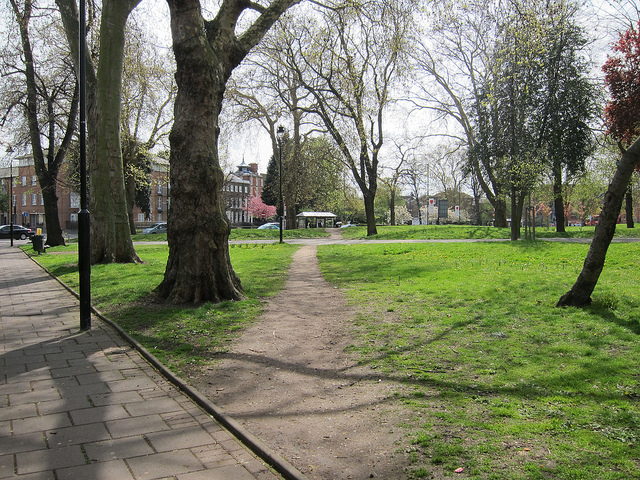Physical Address
304 North Cardinal St.
Dorchester Center, MA 02124
Physical Address
304 North Cardinal St.
Dorchester Center, MA 02124
Someone just posted a video on Youtube using Houston, Texas as an argument in favor of zoning. The logic of the video is: Houston is horrible; Houston has no zoning; therefore every city should have conventional zoning. This video and its logic are impressively wrong, for several reasons. First, I’ve been to Houston and most of what I saw looks nothing like the video – there are plenty of blocks dominated by houses and the occasional condo. Second, most of the photos in the video could have easily happened in a zoned city, because one block in a neighborhood could be residential and the next block could be commercial, so the commercial or industrial activities can be easily viewable from the residential areas (not that anything is wrong with that). Third, most other automobile-dependent cities aren’t any prettier than Houston; a strip mall in Houston doesn’t look any worse than a strip mall in Atlanta. Fourth, it completely overlooks the negative side effects of zoning as it is practiced in most of the United States (many of which have been addressed more than once on this site). Typically, residential zones are so enormous that most of their residents cannot walk to a store or office. Moreover, density limits everywhere limit the supply of modest housing, thus creating housing shortages and homelessness. Finally, Houston’s negative characteristics are partially a result of government spending and regulation; as I have written elsewhere, that city has historically had a wide variety of anti-walkability policies, so it is far more regulated than the video suggests.
A stickplex is a dense residential structure or group of structures built with inexpensive materials and techniques, most commonly wood. Stickplexes use 2,500 square feet of land per unit or less. Stickplexes have per-square-foot construction costs roughly in line with detached houses due to avoidance of costly features like elevators and more expensive construction methods. This type of housing includes features of both multifamily housing and single-family housing. They economize on land while avoiding the high construction costs of large multifamily buildings. Relative to high-rise housing, stickplexes can cost one-third less to build on a per-square-foot basis. And because they use a relatively small amount of land per unit, their land costs are lower than the typical detached house’s land costs. Stickplexes versus missing middle Daniel Parolek coined the term “missing middle” and emphasizes that missing middle “is compatible in scale with single-family homes.” He advises caution about permitting three-story buildings, while a stickplex can be three stories or taller. A duplex on a 6,000 square foot lot would fit the definition of missing middle. But it would not be a stickplex since it would use more than 3,000 square feet of land per unit. Missing middle housing has found traction politically. Policymakers who have passed zoning reforms from Oregon to Nebraska to Durham have used the term to describe the type of construction they would like to see. Minneapolis Council Member Lisa Goodman described the city’s reform to permit triplexes in language similar to Parolek’s: “I like to refer to it as, ‘the box can’t change,” she said. “All that can change is how many families can live within the existing box.” However, in Minneapolis, questions remain about how feasible triplexes will be to build in permitted building envelopes. Zoning rules, including floor area ratio limits of less than one […]

Nolan Gray plunges into the Sam Raimi "Spider-Man" trilogy to uncover the housing problems (and solutions) of expensive cities like New York.
I had always thought dollar stores were a nice thing to have in an urban neighborhood, but recently they have become controversial. Some cities have tried to limit their growth, based on the theory that “they impede opportunities for grocery stores and other businesses to take root and grow.” This is supposedly a terrible thing because real grocery stores sell fresh vegetables and dollar stores don’t. In other words, anti-dollar store groups believe that people won’t buy nutritious food without state coercion, and that government must therefore drive competing providers of food out of business. Recently, I was at the train stop for Central Islip, Long Island, a low-income, heavily Hispanic community 40 miles from Manhattan. There is a Family Dollar almost across the street from the train stop, and guess what is right next to it, in the very same strip mall? You guessed it- a grocery store! * It seems to me that dollar stores and traditional grocery stores might actually be complementary, rather than competing uses. You can get a lot of non-food items and a few quick snacks at a dollar store, and then get a more varied food selection at the grocery next door. So it seems to me that the widespread villification of dollar stores may not be completely fact-based. Having said that, I’m not ready to say that my theory is right 100 percent of the time. Perhaps in a very small, isolated town (or its urban equivalent), there might be just enough buying power to support a grocery store or a dollar store, but not both. But I suspect that this is a pretty rare scenario in urban neighborhoods. *If you want to see what I saw, go on Google Street View to 54 and 58 E. Suffolk Avenue in Central Islip.
One common argument raised by NIMBYs is that zoning is not harmful to humans, because people priced out of expensive cities can always move to a cheaper one. But a recent story illustrates why this argument is misguided: the story discusses increased housing prices in small cities like Boise and Grand Rapids. When people are priced out of expensive, they move to cheaper ones, thus increasing demand for housing in the cheaper cities. In turn, this causes housing prices to increase in the cheaper cities. In a nation with lots of restrictive zoning, you can’t escape high rents because the high rents will follow you wherever you go. To take the argument further: some people justify local control over zoning by saying that what city X does is its own business. But when city X does things that harm city Y, its policies become the business of the state and federal governments. If city X has restrictive zoning, its policies raise housing costs in whatever city takes in X’s rent refugees- so at that point, a higher level of government should step in.

Desire for Density is a new framework explaining how market prices form a desire path showing where the market could deliver more affordable housing than it presently is.?

Zoning regulations inflict great harm. But it is difficult for Americans to imagine the cost of zoning in Indian cities. Delhi is one of the most crowded cities in the world, and there is great demand for floor space. But real estate developers are not allowed to build tall buildings.

We are blessed and cursed to live in times in which most smart people are expected to have an opinion on zoning. Blessed, in that zoning is arguably the single most important institution shaping where we live, how we move around, and who we meet. Cursed, in that zoning is notoriously obtuse, with zoning ordinances often cloaked in jargon, hidden away in PDFs, and completely different city-to-city. Given this unusual state of affairs, I’m often asked, “What should I read to understand zoning?” To answer this question, I have put together a list of books for the zoning-curious. These have been broken out into three buckets: “Introductory” texts largely lay out the general challenges facing cities, with—at most—high-level discussions of zoning. Most people casually interested in cities can stop here. “Intermediate” texts address zoning specifically, explaining how it works at a general level. These texts are best for people who know a thing or two about cities but would like to learn more about zoning specifically. “Advanced” texts represent the outer frontier of zoning knowledge. While possibly too difficult or too deep into the weeds to be of interest to most lay observers, these texts should be treated as essential among professional planners, urban economists, and urban designers. Before I start, a few obligatory qualifications: First, this not an exhaustive list. There were many great books that I left out in order to keep this list focused. Maybe you feel very strongly that I shouldn’t have left a particular book out. That’s great! Share it in the comments below. Second, while these books will give you a framework for interpreting zoning, they’re no substitute for understanding the way zoning works in your specific city. The only way to get that knowledge is to follow your local planning journalists, attend local […]

Over the past few years, Japanese zoning has become popular among YIMBYs thanks to a classic blog post by Urban kchoze. It’s easy to see why: Japanese zoning is relatively liberal, with few bulk and density controls, limited use segregation, and no regulatory distinction between apartments and single-family homes. Most development in Japan happens “as-of-right,” meaning that securing permits doesn’t require a lengthy review process. Taken as a whole, Japan’s zoning system makes it easy to build walkable, mixed-use neighborhoods, which is why cities like Tokyo are among the most affordable in the developed world. But praise for Japanese zoning skirts an important meta question: Why did U.S. zoning end up so much more restrictive than Japanese zoning? To frame the puzzle a different way, why did U.S. and Japanese land-use regulation—which both started off quite liberal—diverge so dramatically in terms of restrictiveness? I will suggest three factors; the first two set out the “why” for restrictive zoning and the third sets out the “how.” Any YIMBY efforts to liberalize cities in the long term must address these three factors. First, the U.S. privileges real estate as an investment where Japan does not, incentivizing voters to prohibit new supply with restrictive zoning. Second, most public services in the U.S. are administered at the local level, driving local residents to use exclusionary zoning to “preserve” public service quality. Third, the U.S. practice of near-total deference to local land-use planning and widespread use of discretionary permitting creates a system in which local special interests can capture zoning regulation and remake it around their interests. At the outset, why might Americans voters demand stricter zoning than their Japanese counterparts? One possibility is that they are trying to preserve the value of their only meaningful asset: their home. In the U.S., we use housing […]

Believe it or not, the YIMBY movement won a lot in 2018. It kicked off with January’s high of California State Senator Scott Wiener’s introduction of SB 827, which would have permitted multifamily development near transit across the state, but fell to a low after its eventual defeat in committee, invariably followed by a flurry of think pieces about how the pro-development movement had “failed.” At the time, I made the case for optimism over on Citylab, but that didn’t stop the summer lull from becoming a period of soul searching within the movement. And then, a strange thing happened: YIMBYs started winning, and winning big. In August, presidential-hopeful Senator Cory Booker released a plan to preempt exclusionary zoning using Community Development Block Grant funds, quickly followed by a similar plan from Senator Elizabeth Warren in September. Also in August, Housing and Urban Development Secretary Ben Carson unexpectedly outed himself as a YIMBY. Then, in December, things really got crazy: two major North American cities, Minneapolis and Edmonton, completely eliminated single-family zoning. States like Oregon soon started talking about doing the same. In the same month, California kicked into overdrive: San Francisco—ground zero for the YIMBY movement—scrapped minimum parking requirements altogether. State Senator Wiener introduced a newer, sharper version of SB 827. And rolling into 2019, elected officials at every level of California government—from the state’s new Democratic governor to San Diego’s Republican mayor—are singing from the YIMBY hymn sheet. All in all, it wasn’t a bad year for a movement that’s only five years old. But what really made 2018 such an unexpected success for YIMBYs? Focus on Citywide Reform Over Individual Rezonings Showing up and saying “Yes!” to individual projects that are requesting a rezoning, variance, or special permit is bread-and-butter YIMBY activism. And while YIMBYs should still […]